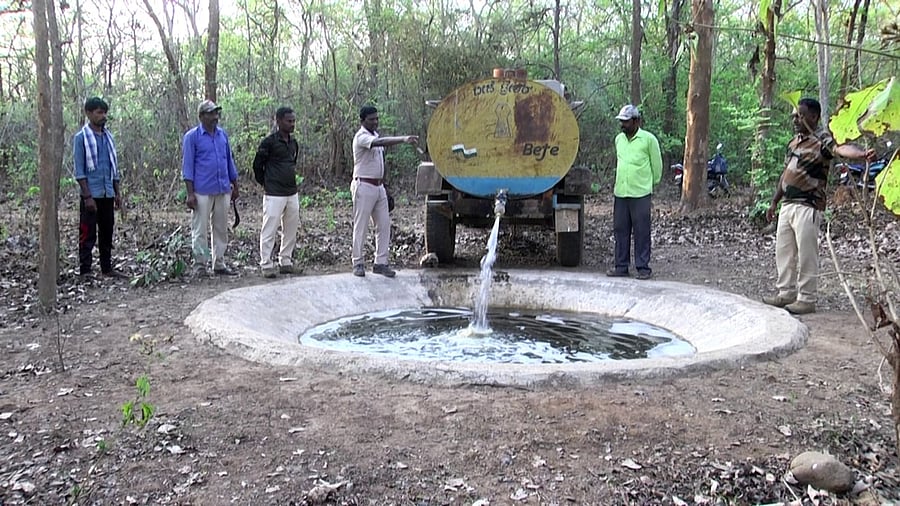
Forest Department staff fill an artificial pond created by the Department in the forest area in Dharwad, with water to quench the thirst of wild animals and birds.
Credit: DH Photo
Dharwad: As the harsh summer has set in, a water crisis has started to surface as the waterbodies are drying up. The situation is tough for the animals and birds, who are facing the intense heat and struggling to quench their thirst.
While birds and animals in and around human habitats find various sources to quench their thirst, wildlife in forests often struggle to find drinking water during summer.
Anticipating this year’s water crisis, the forest department has taken innovative measures to provide water to the animals.
Even though there have been brief showers in the afternoons over the past two days, the scorching heat remains unchanged, intensifying by the hour. The wildlife in the forests is not spared from this heat. There have been numerous instances of wild animals straying into human settlements in search of food and water. Considering this, the forest department has set up water sources for wildlife.
Artificial ponds
In the protected forest areas of Dharwad, Kalghatgi, and Alnavar taluks, the department has created artificial tanks and ponds, which are regularly filled with water. Whenever these water sources dry up, water tankers are deployed to refill them, ensuring that animals do not suffer from thirst.
Dharwad, classified as a semi-malnad region, lacks permanent water sources despite having vast forest cover and diverse wildlife. As summer sets in, the natural ponds and lakes dry up, creating hardships for wild animals. Acknowledging this issue years ago, the forest department had started constructing water pits before the arrival of summer.
Previously, pits were dug in the middle of the forest, lined with plastic sheets, and filled with water. However, animals hesitated to enter these pits despite their thirst. To address this, the department has now constructed scientifically designed water pits, making it easier for animals to drink without fear.
Earlier, water in these pits would not last for more than two days. Animals stepping in to drink would tear the plastic linings with their claws, causing water to seep into the ground. Additionally, animals had to step into the pits to drink, making it challenging for smaller animals like deer, hares, and monkeys. Entering the pits also made them vulnerable to attacks by larger predators.
Concrete water troughs
To solve these issues, officials have installed multiple small concrete water troughs, embedding them into the ground. In areas with a higher wildlife population, larger and scientifically designed water tanks have been constructed. Since these troughs are at ground level, animals no longer fear falling into them. Larger tanks also feature ramps, allowing animals to step in and drink water comfortably.
Assistant Conservator of Forest Parimala stated, “Every summer, wildlife faces water scarcity. To address this, our forest department personnel have been refilling these water sources in areas where animals frequently visit. Our efforts have been successful, as animals are coming and drinking water regularly.”
Relief for thirsty wildlife.
Every day, numerous species of birds and animals are seen drinking water from these sources. Camera traps have captured images documenting this activity. In the past month alone, leopards, bears, wild boars, foxes, peacocks, and monkeys, among other wildlife, have been recorded drinking from these sources. Ultimately, this initiative by the forest department has brought relief to the thirsty wildlife.
“Many nature lovers have extended their support for our efforts to provide water for forest animals, which is a new and welcome development. Several individuals have donated small concrete water tanks for monkeys, foxes, squirrels, and birds. These have been embedded into the ground at various locations and are refilled daily. Animals residing far from large lakes and tanks now come regularly to these small tanks to quench their thirst, which is truly satisfying,” said DCF Vivek Kawari.